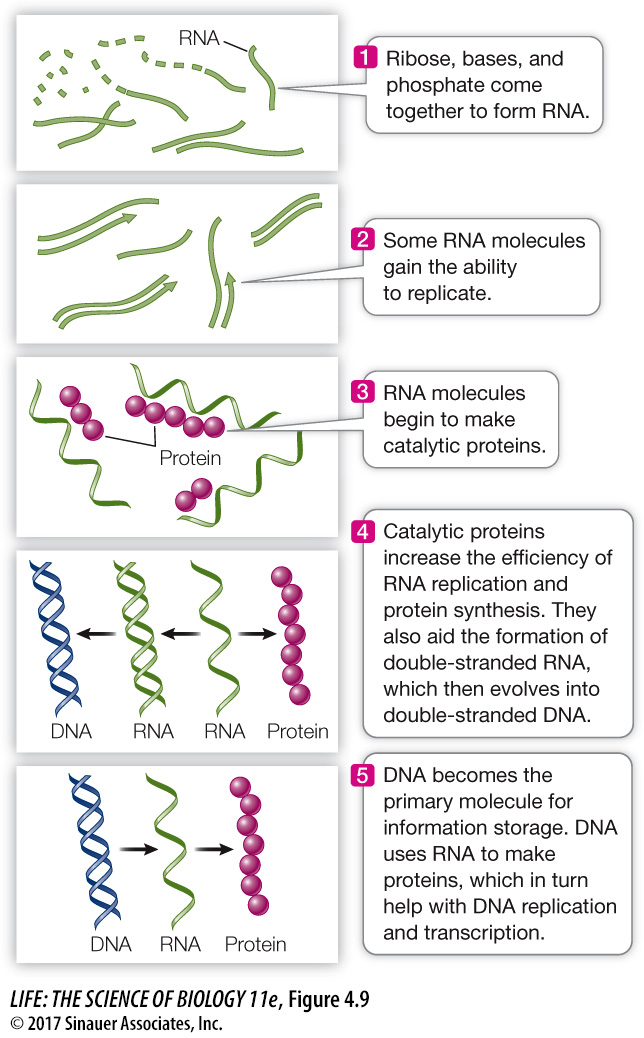RNA may have been the first biological catalyst
Many chemical changes occur in living organisms: an example is DNA replication, which we described earlier in this chapter as the process by which a molecule of DNA is duplicated (see Figure 4.5). Many other chemical changes occur in living systems, often involving the hydrolysis or synthesis of macromolecules or conversions among small molecules. As you will see in Chapter 8, these chemical changes can occur spontaneously in aqueous solutions like those that exist in biological systems, but most would occur extremely slowly. Catalysts—molecules that speed up biochemical conversions—solve this problem. So a key to the origin of life is the appearance of catalysts.
Today, the main catalysts in organisms are proteins called enzymes. The many shapes of proteins allow them to bind to diverse substances in solution and speed up chemical reactions. But we know that proteins are made based on information in nucleic acids. So we have a chicken-or-egg problem: If proteins are needed for life, nucleic acids must have appeared first, so that the proteins could be made. But if nucleic acids appeared before proteins, proteins could not have been the first catalysts. Could nucleic acids be catalysts, in addition to their role as blueprints for protein synthesis? The answer is yes.
Like a protein, the three-dimensional structure of a folded RNA molecule presents a unique surface to the external environment (see Figure 4.3). The surfaces of RNA molecules can be every bit as specific as those of proteins. The three-dimensional shapes and other chemical properties of certain RNA molecules allow them to function as catalysts. Catalytic RNAs, called ribozymes, can speed up reactions involving their own nucleotides as well as other cellular substances. Although in retrospect it is not too surprising, the discovery of catalytic RNAs was a surprise to a community of biologists who were convinced that all biological catalysts were proteins (enzymes). It took almost a decade for the work of the scientists involved, Thomas Cech and Sidney Altman, to be fully accepted by other scientists, but when it was, the two were awarded the Nobel Prize.
Given that RNA can be both informational (in its nucleotide sequence) and catalytic (because of its ability to form unique three-dimensional shapes), it has been hypothesized that early life consisted of an “RNA world”—a world before DNA. It is thought that when RNA was first made, it could have acted as a catalyst for its own replication as well as for the synthesis of proteins. DNA could eventually have evolved from RNA (Figure 4.9). Several lines of evidence support this scenario:
In living organisms today, the formation of peptide linkages (see Figure 3.6) is catalyzed by ribozymes.
In certain viruses called retroviruses, there is an enzyme called reverse transcriptase that catalyzes the synthesis of DNA from RNA.
When a short, naturally occurring RNA molecule is added to a mixture of nucleotides, RNA polymers are formed at a rate 7 million times greater than the formation of polymers without the added RNA. This indicates that the added RNA is a catalyst, not just a template.
An artificial ribozyme has been developed that can catalyze the assembly of short RNAs into a longer molecule that is an exact copy of itself. This may be how nucleic acid replication evolved.

Figure 4.9 The “RNA World” Hypothesis This view postulates that in a world before DNA, RNA alone was both the blueprint for protein synthesis and a catalyst for its own replication. Eventually, the information storage molecules of DNA could have evolved from RNA.
